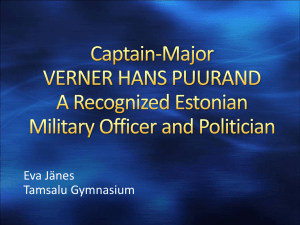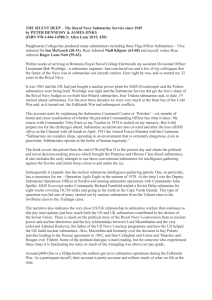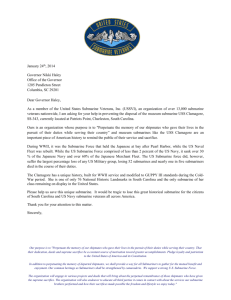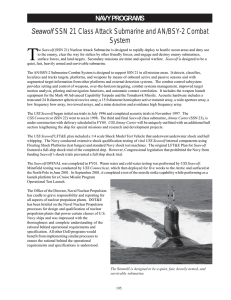USWN_26Aug2015
advertisement
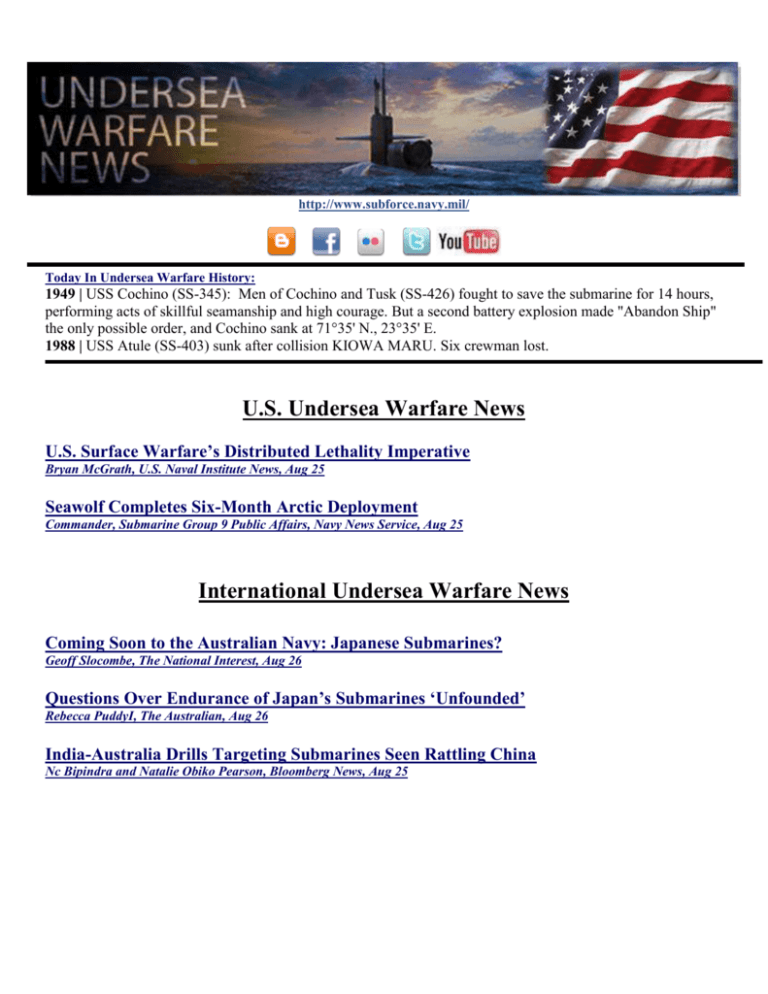
http://www.subforce.navy.mil/ Today In Undersea Warfare History: 1949 | USS Cochino (SS-345): Men of Cochino and Tusk (SS-426) fought to save the submarine for 14 hours, performing acts of skillful seamanship and high courage. But a second battery explosion made "Abandon Ship" the only possible order, and Cochino sank at 71°35' N., 23°35' E. 1988 | USS Atule (SS-403) sunk after collision KIOWA MARU. Six crewman lost. U.S. Undersea Warfare News U.S. Surface Warfare’s Distributed Lethality Imperative Bryan McGrath, U.S. Naval Institute News, Aug 25 Seawolf Completes Six-Month Arctic Deployment Commander, Submarine Group 9 Public Affairs, Navy News Service, Aug 25 International Undersea Warfare News Coming Soon to the Australian Navy: Japanese Submarines? Geoff Slocombe, The National Interest, Aug 26 Questions Over Endurance of Japan’s Submarines ‘Unfounded’ Rebecca PuddyI, The Australian, Aug 26 India-Australia Drills Targeting Submarines Seen Rattling China Nc Bipindra and Natalie Obiko Pearson, Bloomberg News, Aug 25 U.S. Undersea Warfare News U.S. Surface Warfare’s Distributed Lethality Imperative Bryan McGrath, U.S. Naval Institute News, Aug 25 This year, the U.S. Navy’s surface force is busily war-gaming and analyzing its distributed lethality concept in order to fairly evaluate its potential benefits, risks and costs. In seeking to increase the unit lethality of as many surface ships as is practicable, and then operating them in surface action groups (SAGs) – among other innovative adaptive force packages – more widely dispersed from other concentrations of naval power, the surface force aims to provide combatant commanders with an array of options for Phase 0 and 1 responses against high-end opponents, and options for Phase 3 operations geared toward conflict termination. Those options, which preserve other elements of the force for other demanding tasks while laying before an adversary numerous operational targeting and surveillance challenges, force that adversary to devote resources to a naval force that is in totality, more powerful, from more attack angles than today’s force. In addition to complicating an adversary’s operational problem, the imperative for distributed lethality rests on at least three other assumptions. The first imperative for distributed lethality concerns Phase 0 (shaping)/1 (deterrence) operations, and that is the deterrent value of a more powerful surface force capable of holding more and more diverse adversary targets at risk. In an approach reminiscent of the conclusion of the 1983 thriller War Games – in which the anthropomorphic computer concedes that the “only way to win is not to play” – deterring conflict with a great power should be considered the one of the most important – if not the most important – goal of conventional naval forces. By arraying more powerful surface forces and operating them as part of a multinational deterrence posture, the opportunity for maintaining conflict at Phase 1 increases, creating decision space for national leadership by delaying or negating the transition to what could be a ruinous war. Obviously, surface forces would be part of a larger joint deterrence campaign, but as it is, the lethality gaps in the force result in considerably less combat power than could relatively easily be gained by an opportunistic pursuit of the instruments of distributed lethality. The second imperative follows from the first, and that is, if deterrence fails, forward deployed surface forces must be capable of “fighting their way out” of a demanding anti-access area denial (A2/AD) environment. An element of this imperative is resident in the common refrain of critics that the surface force is not “survivable” in this element, a charge which, while generally fair, ignores the fact that virtually everything else in that element is also not survivable. Additionally, the fact that well-intentioned post- Cold War fleet architectural planning devalued the very weapons and sensors that previously buttressed surface force lethality, offers the path and opportunity to mitigate this vulnerability through additional Surface Force hardening. Simply put, if conflict with a high-end adversary commenced with little warning, much of the deployed joint force – not just surface forces – would initially be at risk. The mobility of surface forces provides them with a measure of safety and survivability, and it is reasonable to assume that standing toe to toe with an A2/AD adversary in an unattrited information surveillance and reconnaissance (ISR) environment would be unwise. These surface forces would in all likelihood, sortie to areas of less dense weapon and sensor coverage, out of effective range of the opponent’s striking force, there to await the follow-on campaign to reverse the aggression already under way. Yet if those forward deployed U.S. forces were under active surveillance by the adversary’s fleet at conflict start, their largely unarmed (with effective anti-surface weapons (ASuW)) condition renders them especially vulnerable. Shift ahead ten years from now, to a surface force in which forward deployed combatants (both small and large) field a range of both supersonic and subsonic ASuW missiles capable of targeting opponents out to 1,000 nautical miles, investing that force with the ability to destroy elements of the adversary fleet and valuable land targets while redeploying for follow-on tasking. The final imperative for Distributed Lethality is the impact that a more lethal and distributed surface force would have on conflict termination. Actual high-end warfare with a peer competitor is likely to be nasty business, and a good bit of that combat – while combatant forces remain generally well matched – will be conducted by the Navy’s submarine force (as part of a joint campaign). Once the tide has turned and the adversary’s ISR complex is attrited to the point that a broader, combined arms naval campaign can be waged, lethal and dispersed surface forces – along with carrier strike groups – will play a tremendous role in taking the fight to the adversary, enabling joint operational access, tightening the noose of distant blockade, and generally accelerating the prospects for victory. Again – seizing this advantage requires a seachange in thinking, one in which empowered (by doctrine and capability) commanding officers and crews, given broad mission type orders, exploit opportunities gained earlier in the campaign. It is essential that defense planners thoroughly evaluate the imperative for distributed lethality and ensure that programs and budget submissions are consonant with these imperatives. Warfighters and planning staffs at the Naval Component Commands need to begin to think differently about how surface forces can and should be employed, and how hardening surface forces can gain valuable time early in a conflict while providing for effective conflict termination later in the fight. Bryan McGrath is the managing director of The FerryBridge Group LLC and the assistant director of Hudson Institute’s Center for American Seapower. He is actively engaged with the Navy’s surface force in the development of the distributed lethality concept. Back to Top Seawolf Completes Six-Month Arctic Deployment Commander, Submarine Group 9 Public Affairs, Navy News Service, Aug 25 BREMERTON, Wash. – The fast-attack submarine USS Seawolf (SSN 21) returned to its homeport of Naval Base Kitsap-Bremerton Aug. 21, following a six-month deployment. During the deployment, Seawolf conducted routine submarine operations, which included scheduled under-ice transits and under-ice operations. "The crew performed superbly on multiple operations in the 6th Fleet area of responsibility," said Cmdr. Jeff Bierley, Seawolf's commanding officer, from Birmingham, Alabama. "We conducted two polar transits, including a routine surfacing at the North Pole. Operations under the Arctic are part of the Navy's continued commitment to maintain access to all international seas, and Seawolf was just part of that commitment." The Navy has been operating in the Arctic for decades and it is expected that presence requirements will likely increase as maritime traffic in the region increases. Ships like Seawolf support the Arctic national strategy by developing capabilities, increasing maritime awareness and preserving freedom. "Seawolf did an exceptional job; they had an accelerated fleet readiness training period so they were really pushed to get all of their preparations, training and certifications done before deployment, including preparations for the very challenging Arctic transit," said Capt. Douglas Perry, commander, Submarine Development Squadron 5, from Alexandria, Virginia. "Arctic transits are important, not just for us to be able to keep our fleet assets around the globe, but it also give us an opportunity to maintain undersea dominance of the Arctic spaces, an area that is very challenging and is changing dramatically." This was the first deployment for many of the Sailors aboard Seawolf, awarding them the unique experience of visiting the North Pole. "It was a very interesting deployment full of mixed emotions and the unexpected," said Yeoman 3rd Class Felipe Aparicio, from Los Angeles. "Surfacing at the North Pole was awesome. As you push through the surface it takes your breath away. You feel the ice hit the hull of the boat and you hear thumping back and forth all around you; then it just stops. It was a memorable experience. We got out of the boat, and the best way to describe the North Pole is that it's a cold, snowy desert." These polar transits and the surfacing of submarines demonstrate the U.S. Navy's commitment to assure access to all international waters. USS Nautilus (SSN 571) was the first submarine to complete a submerged polar transit. "We are very happy to be home to the Pacific Northwest, and we are eager to spend time with our family and friends," said Bierley. Seawolf, commissioned July 19, 1997, is the first of the Navy's three Seawolf-class submarines. The Seawolf is significantly quieter than any Los Angeles-class submarine. It is also faster, has more torpedoes tubes and can carry up to 50 torpedoes or missiles, or 100 mines. All of the Seawolf-class submarines are homeported in the Pacific Northwest – USS Connecticut (SSN 22) and Seawolf at Bremerton, Washington, and USS Jimmy Carter (SSN 23) at Naval Base Kitsap-Bangor. Back to Top International Undersea Warfare News Coming Soon to the Australian Navy: Japanese Submarines? Geoff Slocombe, The National Interest, Aug 26 If Australia is to choose the Japanese contender for their future submarine then it should be because it’s the best fit for our ongoing strategic requirements, fully meets project criteria, and is the most economically viable from now until the end of the 2060’s. This decision shouldn’t be a ‘captain’s pick.’ The Soryu-class (‘Blue Dragon’) submarine provides the capability the Japanese Maritime Self-Defense Force’s needs. But the current Soryu-class won’t meet Australia’s requirements. We will need Soryu Mark Two (Goryu? ‘Australian Dragon’) as a completely new design, which will have cost, performance and schedule risks. It won’t be a Military off-the-Shelf (MOTS) acquisition, as some seem to think. Similarly, the hull can’t be built in Japan and fully fitted out in Australia. The Soryu fleet includes six commissioned vessels, which have a surface displacement of 3,480 tons (compared with the Collins-class 3,100 tons) and are 84 meters long. A further five are in various stages of construction. There’s a continuous build program, with both Mitsubishi Heavy Industries (MHI) and Kawasaki Heavy Industries (KHI) involved and alternating the start of each new vessel. There are a number of major changes required for Mark Two in evolving a design to meet RAN’s requirements. This is no simple matter and presumably the CEP will establish how this could be accomplished. The Soryu-class are currently operated and maintained for a service life of 20 years. Australia will want 30 years. Welding techniques, the steel used, corrosion control and number of compression/decompression cycles from deep dives all affect service life. So too do the maintenance and upgrade arrangements—Japan will need to create a new upkeep plan for Mark Two. Australia needs a greater range than the current Soryu. The Collins-class has a range of 11,500 nautical miles at 10 knots surfaced and 9,000 nautical miles snorkeling just sub-surface at the same speed. Fully submerged it has a range of 480 nautical miles at 4 knots, when running on lead-acid batteries. Soryu has a surface range of 6,100 nautical miles at 6.5 knots, faster underwater. This will need to be increased in Mark Two by more fuel-efficient engines and extra bulk fuel storage— perhaps by filling some water ballast space with fuel, to get longer range. Remaining silently at depth for periods of up to 35 days, while travelling slowly for approximately 4,000 nautical miles in the patrol area, will be important for Australia’s next submarines. Although not specified explicitly in the CEP criteria, Australia needs an excellent Air Independent Propulsion (AIP) system and specialist batteries to give the required endurance. The Japanese have obviously made significant progress with Lithium ion batteries (LiBs) to the point where they are proposing that the final two Soryus being constructed in Japan about 2020 abandon their Stirling AIP engines and have only LiBs. LiBs are much more energy dense, providing up to four times as much power in the same space as occupied by classic lead accumulators. If this happens, this is a major technology advance as currently no commissioned diesel-electric submarine in the world has gone to sea with LiBs. Diesel engine-driven battery charging technology needs to adapt to the new requirements—the need for much more electrical power for faster charging possible with LiBs. Currently, Soryus have two chargers, while Collinsclass have three. This has significant implications for detectable snorkel depth battery charging time, which means that Soryus currently may have the higher indiscretion ratio. Mark Two must do much better. Soryu Mark Two will be offered with a permanent magnet synchronous electric motor, with the advantage that brings of high torque at low revolutions, keeping propeller noise to a minimum and avoiding the need for a gearbox. The Soryu-class have a Hitachi command and control system, while Australia wants the U.S. AN-BYG-1 installed, a first for Japan. In terms of weaponry, the Soryus can launch Type 89 torpedoes, Harpoon missiles, and mines. Australia wants Mark 48 Mod 7 CBASS torpedoes, mines and probably the same UGM-84C Sub-Harpoon missiles as fitted in Collins Class. There will also be issues over which type of sonars should be fitted. Cultural differences between the Japanese and Australian defense industries will be challenging. If they’re lining up an Australian-based partner to help them deal with the serious issues ahead, there’s been no public disclosure as yet. The best chance for a successful Mark Two design and construction program with MHI and KHI, as Australia’s international partners, appears to be a hybrid build. The first one or two submarines would be built completely in Kobe, with heavy involvement by Australian designers and shipyard workers there, before construction shifts to Adelaide for the remaining vessels in the project. In the political arena, given that China is Australia’s number one trading partner, what would be the impact of teaming with Japan and the U.S. in what will be seen by China as a strategic coalition to contain their naval expansion? Neither French nor German CEP contenders have this problem. Back to Top Questions Over Endurance of Japan’s Submarines ‘Unfounded’ Rebecca PuddyI, The Australian, Aug 26 Questions over the endurance of Japan’s submarines are unfounded, with the range of the country’s Soryu-class capable of satisfying Australia’s needs, the head of a visiting Japanese delegation has said. Admiral Takashi Saito, the former chief of staff of Japan’s Self Defense Force, will today provide an industry briefing in Adelaide outlining the country’s approach to the competitive evaluation process that will decide who builds Australia’s future submarine fleet. The delegation will frame its pitch to potential industry partners and the public with the arguments that Japan has a proven history with its domestic submarine construction, the government’s close ties to the submarine industry reduces risk to Australia and the security benefits of Australia being the only other country in the world to have access to Soryu’s top-secret technology. Mr Saito yesterday told The Australian he was confident the Soryu could be easily modified to meet the requirements of Australia’s Navy, including the enlargement of the fuel tanks to provide greater operational range. “The current Soryu class submarines are fitted for Japanese self defence force requirements ... we are confident that we can meet with Australia’s requirement by simply enlarging the amount of the fuel tank. We do not see any problem,” Mr Saito said. His comments follow concerns raised by Defence Minister Kevin Andrews in July that the capability of the Soryu, especially its range, may not be up to Australia’s requirements. Mr Saito said until now Japan had failed to sufficiently engage with the Australian public about its interest in building submarines and was now embarking on a public relations pitch. “We have not sufficiently communicated with the Australian public,” Mr Saito said. “We are here to send a message that we are taking this process seriously.” The visit to Adelaide signals a change in the Japanese government’s strategy to win the submarine contract, with Japanese Ambassador to Australia Sumio Kusaka previously saying Japan would not follow France and Germany’s active campaign to win public support. The two other bidders — French firm DCNS and German shipbuilder TKMS — have engaged highly connected Defence figures. TKMS Australia appointed former shipbuilder John White as chairman in April, while the former chief of staff to Defence minister David Johnson, Sean Costello, is now heading up DCNS Australia. Mr Saito, who toured ASC’s Adelaide shipyards on a previous visit, said they were “wonderful”, with enviable wide spaces that were not possible in Japan. Defence Minister Kevin Andrews and Tony Abbott will not meet with the delegation while they are in Australia, leaving discussions about Japan’s bid to the Defence department. “We welcome the visiting delegations of all three potential international partners and we encourage them to continue their active participation in the process,” Mr Andrews said. Back to Top India-Australia Drills Targeting Submarines Seen Rattling China Nc Bipindra and Natalie Obiko Pearson, Bloomberg News, Aug 25 India and Australia will focus on anti-submarine warfare in their first ever joint naval exercises, signaling a growing strategic relationship to counter China’s increased activity in the Indian Ocean. The war games starting Sept. 11 off India’s Visakhapatnam port in the Bay of Bengal will include exercises to protect a tanker from a hostile attack submarine. The area is near waters where China deployed a nuclear-powered submarine for the first time last year, as well as the Sri Lankan port where another unit surfaced twice. That caused a diplomatic uproar. There’s the “potential for increased security tensions in the Indian Ocean,” said Captain Sheldon Williams, defense adviser at the Australian High Commission in New Delhi. “We sit right in the confluence of the Indian and Pacific Oceans. We have a significant responsibility for its security. That’s how we’re looking at it now.” The drills – first discussed a decade ago – come as global powers vie for greater influence. The Indian Ocean’s sea lanes account for nearly half of the world’s container trade, including 80 percent of China’s oil imports. “We’re seeing a genuine power play in the Indian Ocean,” said Rory Medcalf, head of the National Security College at the Australian National University in Canberra. “Indian security cooperation with the U.S. and its allies is increasing, which rattles the Chinese.” War Games Australia is dispatching Lockheed Martin Corp.’s P-3 anti-submarine reconnaissance aircraft, a Collins submarine, tanker and frigates, Williams said. Among assets India will deploy are Boeing Co.’s P-8 long-range anti-submarine aircraft and a locally manufactured Corvette, said navy spokesman Captain DK Sharma. A month later in the same waters, India and the U.S. will conduct drills that U.S. Ambassador Richard Verma described as the most complex yet between the two nations. Japan has been invited to join. China made strides into a region India considers its traditional sphere of influence, building ports in Pakistan and Sri Lanka, and an oil pipeline to Myanmar’s coast. President Xi Jinping has also lobbied the Maldives, Seychelles and Sri Lanka to join a maritime version of his Silk Road trade rejuvenation project. Most alarming for India, though, has been China’s deployment of submarines near its shores. A nuclearpowered submarine patrolled the Gulf of Aden on a twomonth anti-piracy mission last year, according to Indian media reports citing an advisory from China’s Foreign Ministry to India’s embassy in Beijing. A Chinese submarine also popped up in Sri Lanka’s Colombo port for "replenishment purposes" in September and November. India says another Chinese submarine docked in May and July in Pakistan. Rules-Based Order Those moves are prodding Prime Minister Narendra Modi to align India more closely with the U.S. and a “rules-based” approach for maritime security. That order’s threatened by China’s attempts to assert territorial claims in the South China Sea with the construction of artificial islands and runways. While Australia doesn’t take sides in the South China Sea dispute, it’s concerned about China’s landreclamation activities, Williams said. “Certainly, the tension that that causes is not good for anyone, particularly the potential militarization of those areas,” he said. China doesn’t appear to be backing off. Beijing’s leaders want to complete a free-trade deal with Sri Lanka by year’s end and announced more than $350 million in aid money last month. “India alone cannot assure the security of the Indian Ocean, even if it regards the Indian Ocean as its backyard,” the China Daily said in an editorial. “If the Pacific Ocean is big enough to accommodate China and the U.S., so is the Indian Ocean to accommodate India and China.” Back to Top

